Research Progress on Flexible Oxide-Based Thin Film Transistors
Abstract
1. Introduction
2. Device Fundamental Concept and Conventional Configuration
2.1. Carrier Transport Mechanism of Oxide Semiconductor Materials
2.2. Typical Device Configurations
3. Approaches to Flexible Oxide-Based TFTs
3.1. Flexible TFTs on Different Kinds of Substrates
3.1.1. PET Flexible Substrate
3.1.2. PEN Flexible Substrates
3.1.3. Polyimide (PI) Flexible Substrate
3.2. Flexible TFTs under Mechanical Stress
3.2.1. Bending Test Platforms and Methods
3.2.2. Degradation of TFTs under Mechanical Stress
3.3. Optimized Ways for the Reduction of Mechanical Stress
4. Summary and Outlook
Author Contributions
Funding
Conflicts of Interest
References
- O’Neill, M.; Kelly, S.M. Liquid Crystals for Charge Transport, Luminescence, and Photonics. Adv. Mater. 2010, 15, 1135–1146. [Google Scholar] [CrossRef]
- Laschat, S.; Baro, A.; Steinke, N.; Giesselmann, F.; Hägele, C.; Scalia, G.; Judele, R.; Kapatsina, E.; Sauer, S.; Schreivogel, A. Discotic liquid crystals: From tailor-made synthesis to plastic electronics. Angew. Chem. Int. Ed. 2007, 46, 4832–4887. [Google Scholar] [CrossRef]
- Jau, H.C.; Cheng, K.T.; Lin, T.H.; Lo, Y.S.; Chen, J.Y.; Hsu, C.W.; Fuh, A.Y. Photo-rewritable flexible LCD using indium zinc oxide/polycarbonate substrates. Appl. Opt. 2011, 50, 213. [Google Scholar] [CrossRef]
- Binnemans, K. Ionic liquid crystals. Cheminform 2005, 37, 4148–4204. [Google Scholar]
- Cheng, W.C.; Pedram, M. Power Minimization in a Backlit TFT-LCD Display by Concurrent Brightness and Contrast Scaling. IEEE Trans. Consum. Electron. 2004, 1, 25–32. [Google Scholar] [CrossRef]
- Oschatz, E.; Prokop, M.; Scharitzer, M.; Weber, M.; Balassy, C.; Schaefer-Prokop, C. Comparison of liquid crystal versus cathode ray tube display for the detection of simulated chest lesions. Eur. Radiol. 2005, 15, 1472–1476. [Google Scholar] [CrossRef]
- Liu, Y.H.; Lin, S.H.; Hsueh, Y.L.; Lee, M.J. Automatic target defect identification for TFT-LCD array process inspection using kernel FCM-based fuzzy SVDD ensemble. Expert Syst. Appl. 2009, 36, 1978–1998. [Google Scholar] [CrossRef]
- Tsai, P.S.; Liang, C.K.; Huang, T.H.; Chen, H.H. Image enhancement for backlight-scaled TFT-LCD displays. IEEE Trans. Circuits Syst. Video Technol. 2009, 19, 574–583. [Google Scholar] [CrossRef]
- Moshnyaga, V.G.; Morikawa, E. LCD Display Energy Reduction by User Monitoring. Int. Conf. Comput. Des. 2005, 94–97. [Google Scholar]
- Choi, I.; Shim, H.; Chang, N. Low-power color TFT LCD display for hand-held embedded systems. In Proceedings of the International Symposium on Low Power Electronics and Design, Monterey, CA, USA, 12–14 August 2002; pp. 112–117. [Google Scholar]
- Schadt, M.; Schmitt, K.; Kozinkov, V.; Chigrinov, V. Surface-Induced Parallel Alignment of Liquid Crystals by Linearly Polymerized Photopolymers. Jpn. J. Appl. Phys. 2014, 31, 2155–2164. [Google Scholar] [CrossRef]
- Takezoe, H.; Takanishi, Y. Bent-Core Liquid Crystals: Their Mysterious and Attractive World. Jpn. J. Appl. Phys. 2014, 45, 597–625. [Google Scholar] [CrossRef]
- Luo, Z.; Wu, S.T. A Spatiotemporal Four-Primary Color LCD With Quantum Dots. J. Disp. Technol. 2014, 10, 367–372. [Google Scholar] [CrossRef]
- Steckel, J.S.; Ho, J.; Hamilton, C.; Xi, J.; Breen, C.; Liu, W.; Allen, P.; Coe-Sullivan, S. Quantum dots: The ultimate down-conversion material for LCD displays. J. Soc. Inf. Disp. 2016, 23, 294–305. [Google Scholar] [CrossRef]
- Hwang, J.; Nam, K.; Seo, D. Alignment Properties and EO Performances of Flexible TN-LCD Using Photoalignment Method with the Polymer Film. Mol. Cryst. Liq. Cryst. 2005, 434, 143/[471]–150/[478]. [Google Scholar] [CrossRef]
- Luo, Z.; Chen, Y.; Wu, S.T. Wide color gamut LCD with a quantum dot backlight. Opt. Express 2013, 21, 26269–26284. [Google Scholar] [CrossRef]
- Madsen, L.A.; Dingemans, T.J.; Nakata, M.; Samulski, E.T. Thermotropic biaxial nematic liquid crystals. Phys. Rev. Lett. 2004, 92, 145505. [Google Scholar] [CrossRef]
- Schmidtmende, L.; Fechtenkötter, A.; Müllen, K.; Moons, E.; Friend, R.H.; Mackenzie, J.D. Self-organized discotic liquid crystals for high-efficiency organic photovoltaics. Science 2001, 293, 1119–1122. [Google Scholar] [CrossRef]
- Fujisaki, Y.; Sato, H.; Inoue, Y.; Fujikake, H.; Kurita, T. 10.4: Fast-Response Flexible LCD Panel Driven by a Low -Voltage Organic TFT. Sid Symp. Dig. Tech. Pap. 2012, 37, 119–122. [Google Scholar] [CrossRef]
- Liu, B.; Xu, M.; Wang, L.; Su, Y.; Gao, D.; Tao, H.; Lan, L.; Zou, J.; Peng, J. High-performance hybrid white organic light-emitting diodes comprising ultrathin blue and orange emissive layers. Appl. Phys. Express 2013, 6, 122101. [Google Scholar] [CrossRef]
- Liu, B.; Wang, L.; Xu, M.; Tao, H.; Gao, D.; Zou, J.; Lan, L.; Ning, H.; Peng, J.; Cao, Y. Extremely stable-color flexible white organic light-emitting diodes with efficiency exceeding 100 lm W−1. J. Mater. Chem. C 2014, 2, 9836–9841. [Google Scholar] [CrossRef]
- Liu, B.; Wang, L.; Xu, M.; Tao, H.; Xia, X.; Zou, J.; Su, Y.; Gao, D.; Lan, L.; Peng, J. Simultaneous achievement of low efficiency roll-off and stable color in highly efficient single-emitting-layer phosphorescent white organic light-emitting diodes. J. Mater. Chem. C 2014, 2, 5870–5877. [Google Scholar] [CrossRef]
- Liu, B.; Xu, M.; Wang, L.; Tao, H.; Su, Y.; Gao, D.; Lan, L.; Zou, J.; Peng, J. Very-high color rendering index hybrid white organic light-emitting diodes with double emitting nanolayers. Nano-Micro Lett. 2014, 6, 335–339. [Google Scholar] [CrossRef]
- Wang, Q.; Oswald, I.W.; Perez, M.R.; Jia, H.; Shahub, A.A.; Qiao, Q.; Gnade, B.E.; Omary, M.A. Doping-Free Organic Light-Emitting Diodes with Very High Power Efficiency, Simple Device Structure, and Superior Spectral Performance. Adv. Funct. Mater. 2014, 24, 4746–4752. [Google Scholar] [CrossRef]
- Liu, B.; Luo, D.; Zou, J.; Gao, D.; Ning, H.; Wang, L.; Peng, J.; Cao, Y. A host–guest system comprising high guest concentration to achieve simplified and high-performance hybrid white organic light-emitting diodes. J. Mater. Chem. C 2015, 3, 6359–6366. [Google Scholar] [CrossRef]
- Liu, B.; Wang, L.; Gao, D.; Xu, M.; Zhu, X.; Zou, J.; Lan, L.; Ning, H.; Peng, J.; Cao, Y. Harnessing charge and exciton distribution towards extremely high performance: The critical role of guests in single-emitting-layer white OLEDs. Mater. Horiz. 2015, 2, 536–544. [Google Scholar] [CrossRef]
- Liu, B.; Xu, Z.; Zou, J.; Tao, H.; Xu, M.; Gao, D.; Lan, L.; Wang, L.; Ning, H.; Peng, J. High-performance hybrid white organic light-emitting diodes employing p-type interlayers. J. Ind. Eng. Chem. 2015, 27, 240–244. [Google Scholar] [CrossRef]
- Liu, B.; Zou, J.; Zhou, Z.; Wang, L.; Xu, M.; Tao, H.; Gao, D.; Lan, L.; Ning, H.; Peng, J. Efficient single-emitting layer hybrid white organic light-emitting diodes with low efficiency roll-off, stable color and extremely high luminance. J. Ind. Eng. Chem. 2015, 30, 85–91. [Google Scholar] [CrossRef]
- Liu, B.; Li, X.-L.; Tao, H.; Zou, J.; Xu, M.; Wang, L.; Peng, J.; Cao, Y. Manipulation of exciton distribution for high-performance fluorescent/phosphorescent hybrid white organic light-emitting diodes. J. Mater. Chem. C 2017, 5, 7668–7683. [Google Scholar] [CrossRef]
- Luo, D.; Li, X.-L.; Zhao, Y.; Gao, Y.; Liu, B. High-performance blue molecular emitter-free and doping-free hybrid white organic light-emitting diodes: An alternative concept to manipulate charges and excitons based on exciplex and electroplex emission. ACS Photonics 2017, 4, 1566–1575. [Google Scholar] [CrossRef]
- Luo, D.; Yang, Y.; Huang, L.; Liu, B.; Zhao, Y. High-performance hybrid white organic light-emitting diodes exploiting blue thermally activated delayed fluorescent dyes. Dyes Pigments 2017, 147, 83–89. [Google Scholar] [CrossRef]
- Luo, D.; Yang, Y.; Xiao, Y.; Zhao, Y.; Yang, Y.; Liu, B. Regulating Charge and Exciton Distribution in High-Performance Hybrid White Organic Light-Emitting Diodes with n-Type Interlayer Switch. Nano-Micro Lett. 2017, 9, 37. [Google Scholar] [CrossRef]
- Liu, B.; Wang, L.; Gu, H.; Sun, H.; Demir, H.V. Highly Efficient Green Light-Emitting Diodes from All-Inorganic Perovskite Nanocrystals Enabled by a New Electron Transport Layer. Adv. Opt. Mater. 2018, 1800220. [Google Scholar] [CrossRef]
- Munzenrieder, N.; Karnaushenko, D.; Petti, L.; Cantarella, G.; Vogt, C.; Büthe, L.; Karnaushenko, D.D.; Schmidt, O.G.; Makarov, D.; Tröster, G. Entirely Flexible On-Site Conditioned Magnetic Sensorics. Adv. Electron. Mater. 2016, 2, 1600188. [Google Scholar] [CrossRef]
- Nakata, M.; Motomura, G.; Nakajima, Y.; Takei, T.; Tsuji, H.; Fukagawa, H.; Shimizu, T.; Tsuzuki, T.; Fujisaki, Y.; Yamamoto, T. Development of flexible displays using back-channel-etched In-Sn-Zn-O thin-film transistors and air-stable inverted organic light-emitting diodes. J. Soc. Inf. Disp. 2016, 24, 3–11. [Google Scholar] [CrossRef]
- Petti, L.; Münzenrieder, N.; Vogt, C.; Faber, H.; Büthe, L.; Cantarella, G.; Bottacchi, F.; Anthopoulos, T.D.; Tröster, G. Metal oxide semiconductor thin-film transistors for flexible electronics. Appl. Phys. Rev. 2016, 3, 021303. [Google Scholar] [CrossRef]
- Sheng, J.; Choi, D.; Lee, S.H.; Park, J.; Park, J.S. Performance modulation of transparent ALD indium oxide films on flexible substrates: Transition between metal-like conductor and high performance semiconductor states. J. Mater. Chem. C 2016, 4, 7571–7576. [Google Scholar] [CrossRef]
- Sheng, J.; Jeong, H.-J.; Han, K.-L.; Hong, T.; Park, J.-S. Review of recent advances in flexible oxide semiconductor thin-film transistors. J. Inf. Disp. 2017, 18, 159–172. [Google Scholar] [CrossRef]
- Bahubalindruni, P.G.; Martins, J.; Santa, A.; Tavares, V.; Martins, R.; Fortunato, E.; Barquinha, P. High-Gain Transimpedance Amplifier for Flexible Radiation Dosimetry Using InGaZnO TFTs. IEEE J. Electron Devices Soc. 2018, 6, 760–765. [Google Scholar] [CrossRef]
- bin Wan Zaidi, W.M.H.; Costa, J.; Pouryazdan, A.; Abdullah, W.F.H.; Munzenrieder, N. Flexible IGZO TFT SPICE Model and Design of Active Strain-Compensation Circuits for Bendable Active Matrix Arrays. IEEE Electron Device Lett. 2018, 39, 1314–1317. [Google Scholar] [CrossRef]
- Shin, S.-R.; Lee, H.B.; Jin, W.-Y.; Ko, K.-J.; Park, S.; Yoo, S.; Kang, J.-W. Improving light extraction of flexible OLEDs using a mechanically robust Ag mesh/ITO composite electrode and microlens array. J. Mater. Chem. C 2018, 6, 5444–5452. [Google Scholar] [CrossRef]
- Nomura, K.; Ohta, H.; Takagi, A.; Kamiya, T.; Hirano, M.; Hosono, H. Room-temperature fabrication of transparent flexible thin-film transistors using amorphous oxide semiconductors. Nature 2004, 432, 488–492. [Google Scholar] [CrossRef]
- Eun Lee, J.; Sharma, B.K.; Lee, S.-K.; Jeon, H.; Hee Hong, B.; Lee, H.-J.; Ahn, J.-H. Thermal stability of metal Ohmic contacts in indium gallium zinc oxide transistors using a graphene barrier layer. Appl. Phys. Lett. 2013, 102, 113112. [Google Scholar] [CrossRef]
- Hsu, H.-H.; Chang, C.-Y.; Cheng, C.-H. A Flexible IGZO Thin-Film Transistor With Stacked TiO2-Based Dielectrics Fabricated at Room Temperature. IEEE Electron Device Lett. 2013, 34, 768–770. [Google Scholar] [CrossRef]
- Hong, S.; Mativenga, M.; Jang, J. Extreme bending test of IGZO TFT. In Proceedings of the International Workshop on Active-Matrix Flatpanel Displays & Devices, Kyoto, Japan, 2–4 July 2014. [Google Scholar]
- Hsiao-Hsuan, H.; Chun-Yen, C.; Chun-Hu, C.; Po-Chun, C.; Yu-Chien, C.; Ping, C.; Chin-Pao, C. High Mobility Field-Effect Thin Film Transistor Using Room-Temperature High- Gate Dielectrics. J. Disp. Technol. 2014, 10, 875–881. [Google Scholar] [CrossRef]
- Hsu, H.-H.; Chang, C.-Y.; Cheng, C.-H.; Chiou, S.-H.; Huang, C.-H. High Mobility Bilayer Metal–Oxide Thin Film Transistors Using Titanium-Doped InGaZnO. IEEE Electron Device Lett. 2014, 35, 87–89. [Google Scholar] [CrossRef]
- Hsu, H.-H.; Chang, C.-Y.; Cheng, C.-H.; Chiou, S.-H.; Huang, C.-H.; Chiu, Y.-C. An Oxygen Gettering Scheme for Improving Device Mobility and Subthreshold Swing of InGaZnO-Based Thin-Film Transistor. IEEE Trans. Nanotechnol. 2014, 13, 933–938. [Google Scholar] [CrossRef]
- Lai, H.-C.; Pei, Z.; Jian, J.-R.; Tzeng, B.-J. Alumina nanoparticle/polymer nanocomposite dielectric for flexible amorphous indium-gallium-zinc oxide thin film transistors on plastic substrate with superior stability. Appl. Phys. Lett. 2014, 105, 033510. [Google Scholar] [CrossRef]
- Petti, L.; Munzenrieder, N.; Salvatore, G.A.; Zysset, C.; Kinkeldei, T.; Buthe, L.; Troster, G. Influence of Mechanical Bending on Flexible InGaZnO-Based Ferroelectric Memory TFTs. IEEE Trans. Electron Devices 2014, 61, 1085–1092. [Google Scholar] [CrossRef]
- Rim, Y.S.; Chen, H.; Liu, Y.; Bae, S.H.; Kim, H.J.; Yang, Y. Direct light pattern integration of low-temperature solution-processed all-oxide flexible electronics. ACS Nano 2014, 8, 9680–9686. [Google Scholar] [CrossRef]
- Jung, S.-W.; Choi, J.-S.; Koo, J.B.; Park, C.W.; Na, B.S.; Oh, J.-Y.; Lim, S.C.; Lee, S.S.; Chu, H.Y.; Yoon, S.-M. Flexible nonvolatile organic ferroelectric memory transistors fabricated on polydimethylsiloxane elastomer. Org. Electron. 2015, 16, 46–53. [Google Scholar] [CrossRef]
- Liu, N.; Zhu, L.Q.; Feng, P.; Wan, C.J.; Liu, Y.H.; Shi, Y.; Wan, Q. Flexible Sensory Platform Based on Oxide-based Neuromorphic Transistors. Sci. Rep. 2015, 5, 18082. [Google Scholar] [CrossRef]
- Raja, J.; Jang, K.; Nguyen, C.P.T.; Yi, J.; Balaji, N.; Hussain, S.Q.; Chatterjee, S. Improvement of Mobility in Oxide-Based Thin Film Transistors: A Brief Review. Trans. Electr. Electron. Mater. 2015, 16, 234–240. [Google Scholar] [CrossRef]
- Yu, G.; Wu, C.-F.; Lu, H.; Ren, F.-F.; Zhang, R.; Zheng, Y.-D.; Huang, X.-M. Frequency Performance of Ring Oscillators Based on a-IGZO Thin-Film Transistors. Chin. Phys. Lett. 2015, 32, 047302. [Google Scholar] [CrossRef]
- Zhang, J.; Li, Y.; Zhang, B.; Wang, H.; Xin, Q.; Song, A. Flexible indium-gallium-zinc-oxide Schottky diode operating beyond 2.45 GHz. Nat. Commun. 2015, 6, 7561. [Google Scholar] [CrossRef]
- Han, D.; Zhang, Y.; Cong, Y.; Yu, W.; Zhang, X.; Wang, Y. Fully transparent flexible tin-doped zinc oxide thin film transistors fabricated on plastic substrate. Sci. Rep. 2016, 6, 38984. [Google Scholar] [CrossRef]
- Xiao, X.; Zhang, L.; Shao, Y.; Zhou, X.; He, H.; Zhang, S. Room-Temperature-Processed Flexible AmorphousInGaZnO Thin Film Transistor. ACS Appl. Mater. Interfaces 2017, 10, 25850–25857. [Google Scholar] [CrossRef]
- Wang, Y.; Yang, J.; Wang, H.; Zhang, J.; Li, H.; Zhu, G.; Shi, Y.; Li, Y.; Wang, Q.; Xin, Q. Amorphous-InGaZnO Thin-Film Transistors Operating Beyond 1 GHz Achieved by Optimizing the Channel and Gate Dimensions. IEEE Trans. Electron Devices 2018, 65, 1377–1382. [Google Scholar] [CrossRef]
- Wuu, D.S.; Lo, W.C.; Chiang, C.C.; Lin, H.B.; Chang, L.S.; Horng, R.H.; Huang, C.L.; Gao, Y.J. Transparent Barrier Coatings on Flexible Polyethersulfone Substrates for Moisture-Resistant Applications. Mater. Sci. Forum 2005, 475–479, 4017–4020. [Google Scholar] [CrossRef]
- Jeong, J.K.; Jin, D.U.; Shin, H.S.; Lee, H.J.; Kim, M.; Ahn, T.K.; Lee, J.; Mo, Y.G.; Chung, H.K. Flexible Full-Color AMOLED on Ultrathin Metal Foil. IEEE Electron Device Lett. 2007, 28, 389–391. [Google Scholar] [CrossRef]
- Choi, M.C.; Kim, Y.; Ha, C.S. Polymers for flexible displays: From material selection to device applications. Prog. Polym. Sci. 2008, 33, 581–630. [Google Scholar] [CrossRef]
- Park, J.S.; Kim, T.W.; Stryakhilev, D.; Lee, J.S.; An, S.G.; Pyo, Y.S.; Lee, D.B.; Mo, Y.G.; Jin, D.U.; Chung, H.K. Flexible full color organic light-emitting diode display on polyimide plastic substrate driven by amorphous indium gallium zinc oxide thin-film transistors. Appl. Phys. Lett. 2009, 95, 013503. [Google Scholar] [CrossRef]
- Cheng, H.-C.; Tsay, C.-Y. Flexible a-IZO thin film transistors fabricated by solution processes. J. Alloys Compd. 2010, 507, L1–L3. [Google Scholar] [CrossRef]
- Cheong, W.S.; Bak, J.Y.; Kim, H.S. Transparent Flexible Zinc-Indium-Tin Oxide Thin-Film Transistors Fabricated on Polyarylate Films. Jpn. J. Appl. Phys. 2010, 49, 05EB10. [Google Scholar] [CrossRef]
- Cherenack, K.H.; Munzenrieder, N.S.; Troster, G. Impact of Mechanical Bending on ZnO and IGZO Thin-Film Transistors. IEEE Electron Device Lett. 2010, 31, 1254–1256. [Google Scholar] [CrossRef]
- Chiu, C.J.; Chang, S.P.; Chang, S.J. High-Performance a-IGZO Thin-Film Transistor Using Ta2O5 Gate Dielectric. IEEE Electron Device Lett. 2010, 31, 1245–1247. [Google Scholar] [CrossRef]
- Indluru, A.; Alford, T.L. High-temperature stability and enhanced performance of a-Si:H TFT on flexible substrate due to improved interface quality. IEEE Trans. Electron Devices 2010, 57, 3006–3011. [Google Scholar] [CrossRef]
- Lee, C.Y.; Lin, M.Y.; Wu, W.H.; Wang, J.Y.; Chou, Y.; Su, W.F.; Chen, Y.F.; Lin, C.F. Flexible ZnO transparent thin-film transistors by a solution-based process at various solution concentrations. Semicond. Sci. Technol. 2010, 25, 105008. [Google Scholar] [CrossRef]
- Liu, J.; Buchholz, D.B.; Chang, R.P.; Facchetti, A.; Marks, T.J. High-performance flexible transparent thin-film transistors using a hybrid gate dielectric and an amorphous zinc indium tin oxide channel. Adv. Mater. 2010, 22, 2333–2337. [Google Scholar] [CrossRef]
- Liu, J.; Buchholz, D.B.; Hennek, J.W.; Chang, R.P.H.; Facchetti, A.; Marks, T.J. All-amorphous-oxide transparent, flexible thin-film transistors. efficacy of bilayer gate dielectrics. J. Am. Chem. Soc. 2010, 132, 11934–11942. [Google Scholar] [CrossRef]
- Nomura, K.; Aoki, T.; Nakamura, K.; Kamiya, T.; Nakanishi, T.; Hasegawa, T.; Kimura, M.; Kawase, T.; Hirano, M.; Hosono, H. Three-dimensionally stacked flexible integrated circuit: Amorphous oxide/polymer hybrid complementary inverter using n-type a-In-Ga-Zn-O and p-type poly-(9,9-dioctylfluorene-co-bithiophene)thin-film transistors. Appl. Phys. Lett. 2010, 96, 578. [Google Scholar] [CrossRef]
- Sekitani, T.; Zschieschang, U.; Klauk, H.; Someya, T. Flexible organic transistors and circuits with extreme bending stability. Nat. Mater. 2010, 9, 1015–1022. [Google Scholar] [CrossRef]
- Son, D.H.; Kim, D.H.; Sung, S.J.; Jung, E.A.; Kang, J.K. High performance and the low voltage operating InGaZnO thin film transistor. Curr. Appl. Phys. 2010, 10, e157–e160. [Google Scholar] [CrossRef]
- Song, K.; Noh, J.; Jun, T.; Jung, Y.; Kang, H.Y.; Moon, J. Flexible Electronics: Fully Flexible Solution-Deposited ZnO Thin-Film Transistors (Adv. Mater. 38/2010). Adv. Mater. 2010, 22, 4308–4312. [Google Scholar] [CrossRef]
- Su, N.C.; Wang, S.J.; Huang, C.C.; Chen, Y.H.; Huang, H.Y.; Chiang, C.K.; Chin, A. Low-Voltage-Driven Flexible InGaZnO Thin-Film Transistor With Small Subthreshold Swing. IEEE Electron Device Lett. 2010, 31, 680–682. [Google Scholar]
- Yoo, J.S.; Jung, S.H.; Kim, Y.C.; Byun, S.C.; Kim, J.M.; Choi, N.B.; Yoon, S.Y.; Kim, C.D.; Hwang, Y.K.; Chung, I.J. Highly Flexible AM-OLED Display With Integrated Gate Driver Using Amorphous Silicon TFT on Ultrathin Metal Foil. J. Disp. Technol. 2010, 6, 565–570. [Google Scholar] [CrossRef]
- Zhao, D.; Mourey, D.A.; Jackson, T.N. Fast Flexible Plastic Substrate ZnO Circuits. IEEE Electron Device Lett. 2010, 31, 323–325. [Google Scholar] [CrossRef]
- Chien, C.W.; Wu, C.H.; Tsai, Y.T.; Kung, Y.C.; Lin, C.Y.; Hsu, P.C.; Hsieh, H.H.; Wu, C.C.; Yeh, Y.H.; Leu, C.M. High-Performance Flexible a-IGZO TFTs Adopting Stacked Electrodes and Transparent Polyimide-Based Nanocomposite Substrates. IEEE Trans. Electron Devices 2011, 58, 1440–1446. [Google Scholar] [CrossRef]
- Higaki, T.; Tachibana, T.; Kimura, Y.; Maemoto, T.; Sasa, S.; Inoue, M. Flexible zinc oxide thin-film transistors using oxide buffer layers on polyethylene napthalate substrates. In Proceedings of the 2011 International Meeting for Future of Electron Devices, Osaka, Japan, 19–20 May 2011. [Google Scholar]
- Kim, J.M.; Nam, T.; Lim, S.J.; Seol, Y.G.; Lee, N.E.; Kim, D.; Kim, H. Atomic layer deposition ZnO:N flexible thin film transistors and the effects of bending on device properties. Appl. Phys. Lett. 2011, 98, 205. [Google Scholar] [CrossRef]
- Jeong, J.K. The status and perspectives of metal oxide thin-film transistors for active matrix flexible displays. Semicond. Sci. Technol. 2011, 26, 034008. [Google Scholar] [CrossRef]
- Kinkeldei, T.; Munzenrieder, N.; Zysset, C.; Cherenack, K.; Tröster, G. Encapsulation for Flexible Electronic Devices. IEEE Electron Device Lett. 2011, 32, 1743–1745. [Google Scholar] [CrossRef]
- Mativenga, M.; Choi, M.H.; Choi, J.W.; Jang, J. Transparent Flexible Circuits Based on Amorphous-Indium-Gallium-Zinc-Oxide Thin-Film Transistors. IEEE Electron Device Lett. 2011, 32, 170–172. [Google Scholar] [CrossRef]
- Münzenrieder, N.S.; Cherenack, K.H.; Tröster, G. Testing of flexible InGaZnO-based thin-film transistors under mechanical strain. Eur. Phys. J. Appl. Phys. 2011, 55, 1460–1466. [Google Scholar] [CrossRef]
- Bak, J.Y.; Yoon, S.M.; Yang, S.; Kim, G.H.; Ko Park, S.-H.; Hwang, C.-S. Effect of In-Ga-Zn-O active layer channel composition on process temperature for flexible oxide thin-film transistors. J. Vac. Sci. Technol. B 2012, 30, 041208. [Google Scholar] [CrossRef]
- Kim, D.I.; Hwang, B.U.; Park, J.S.; Jeon, H.S.; Bae, B.S.; Lee, H.J.; Lee, N.E. Mechanical bending of flexible complementary inverters based on organic and oxide thin film transistors. Org. Electron. 2012, 13, 2401–2405. [Google Scholar] [CrossRef]
- Kimura, Y.; Higaki, T.; Maemoto, T.; Sasa, S.; Inoue, M. High transconductance zinc oxide thin-film transistors on flexible plastic substrates. In Proceeding of Aps March Meeting 2012, Boston, MA, USA, 27 February–2 March 2012. [Google Scholar]
- Lai, H.C.; Tzeng, B.J.; Pei, Z.; Chen, C.M.; Huang, C.J. Ultra-flexible Amorphous Indium-Gallium-Zinc Oxide (a-IGZO). Sid Symp. Dig. Tech. Pap. 2012, 43, 764–767. [Google Scholar]
- Munzenrieder, N.; Petti, L.; Zysset, C.; Salvatore, G.A.; Kinkeldei, T.; Perumal, C.; Carta, C.; Ellinger, F.; Troster, G. Flexible a-IGZO TFT amplifier fabricated on a free standing polyimide foil operating at 1.2 MHz while bent to a radius of 5 mm. In Proceedings of the 2012 International Electron Devices Meeting, San Francisco, CA, USA, 10–13 December 2012; pp. 5.2.1–5.2.4. [Google Scholar]
- Munzenrieder, N.; Zysset, C.; Kinkeldei, T.; Petti, L.; Salvatore, G.A.; Troster, G. Mechanically flexible double gate a-IGZO TFTs. In Proceedings of the 2012 European Solid-State Device Research Conference (ESSDERC), Bordeaux, France, 17–21 September 2012; pp. 133–136. [Google Scholar]
- Kronemeijer, A.J.; Akkerman, H.; van der Steen, J.L.; Steudel, S.; Pendyala, R.; Panditha, P.; Bel, T.; van Diesen, K.; de Haas, G.; Maas, J.; et al. Dual-Gate Self-Aligned IGZO TFTs Monolithically Integrated with HighTemperature Bottom Moisture Barrier for Flexible AMOLED. 2018. Available online: https://research.tue.nl/en/publications/dual-gate-self-aligned-igzo-tfts-monolithically-integrated-with-h (accessed on 20 February 2019).
- Park, Y.S.; Kim, H.K. Flexible indium zinc oxide/Ag/indium zinc oxide multilayer electrode grown on polyethersulfone substrate by cost-efficient roll-to-roll sputtering for flexible organic photovoltaics. J. Vac. Sci. Technol. A Vac. Surfaces Films 2010, 28, 41–47. [Google Scholar] [CrossRef]
- Heremans, P.; Papadopoulos, N.; Meux, A.D.J.D.; Nag, M.; Steudel, S.; Rockele, M.; Gelinck, G.; Tripathi, A.; Genoe, J.; Myny, K. Flexible metal-oxide thin film transistor circuits for RFID and health patches. In Proceedings of the IEEE International Electron Devices Meeting (IEDM), San Francisco, CA, USA, 3–7 December 2016. [Google Scholar]
- Hung, M.H.; Chen, C.H.; Lai, Y.C.; Tung, K.W.; Lin, W.T.; Wang, H.H.; Chan, F.J.; Cheng, C.C.; Chuang, C.T.; Huang, Y.S. Ultra low voltage 1-V RFID tag implement in a-IGZO TFT technology on plastic. In Proceedings of the IEEE International Conference on RFID, Phoenix, AZ, USA, 9–11 May 2017; pp. 193–197. [Google Scholar]
- Hoffman, R.L. ZnO-channel thin-film transistors: Channel mobility. J. Appl. Phys. 2004, 95, 5813–5819. [Google Scholar] [CrossRef]
- Fortunato, E.M.C.; Barquinha, P.M.C.; Pimentel, A.C.M.B.G.; Gonçalves, A.M.F.; Marques, A.J.S.; Pereira, L.M.N.; Martins, R.F.P. Fully Transparent ZnO Thin-Film Transistor Produced at Room Temperature. Adv. Mater. 2005, 17, 590–594. [Google Scholar] [CrossRef]
- Hsieh, H.-H.; Wu, C.-C. Scaling behavior of ZnO transparent thin-film transistors. Appl. Phys. Lett. 2006, 89, 041109. [Google Scholar] [CrossRef]
- Yabuta, H.; Sano, M.; Abe, K.; Aiba, T.; Den, T.; Kumomi, H.; Nomura, K.; Kamiya, T.; Hosono, H. High-mobility thin-film transistor with amorphous InGaZnO4 channel fabricated by room temperature rf-magnetron sputtering. Appl. Phys. Lett. 2006, 89, 112123. [Google Scholar] [CrossRef]
- Fortunato, E.M.C.; Pereira, L.M.N.; Barquinha, P.M.C.; Botelho, d.R.; Ana, M.; Goncalves, G.; Vila, A.; Morante, J.R.; Martins, R.F.P. High mobility indium free amorphous oxide thin film transistors. Appl. Phys. Lett. 2008, 92, 044505. [Google Scholar] [CrossRef]
- Delimi, A.; Coffinier, Y.; Talhi, B.; Boukherroub, R.; Szunerits, S. Investigation of the corrosion protection of SiOx-like oxide films deposited by plasma-enhanced chemical vapor deposition onto carbon steel. Electrochim. Acta 2010, 55, 8921–8927. [Google Scholar] [CrossRef]
- Takechi, K.; Nakata, M.; Azuma, K.; Yamaguchi, H.; Kaneko, S. Dual-Gate Characteristics of Amorphous InGaZnO Thin-Film Transistors as Compared to Those of Hydrogenated Amorphous Silicon Thin-Film Transistors. IEEE Trans. Electron Devices 2009, 56, 2027–2033. [Google Scholar] [CrossRef]
- Baek, G.; Abe, K.; Kuo, A.; Kumomi, H.; Kanicki, J. Electrical properties and stability of dual-gate coplanar homojunction DC sputtered amorphous indium-gallium-zinc-oxide thin-film Transistors and its application to AM-OLEDs. IEEE Trans. Electron Devices 2011, 58, 4344–4353. [Google Scholar] [CrossRef]
- Chen, R.; Zhou, W.; Zhang, M.; Kwok, H.S. Top-Gate GaN Thin-Film Transistors Based on AlN/GaN Heterostructures. IEEE Electron Device Lett. 2012, 33, 1282–1284. [Google Scholar] [CrossRef]
- Min, H.C.; Man, J.S.; Mativenga, M.; Geng, D.; Kang, D.H.; Jin, J. P-13: A Full-Swing a-IGZO TFT-Based Inverter with a Top Gate-Induced Depletion Load. Sid Symp. Dig. Tech. Pap. 2012, 42, 1144–1147. [Google Scholar]
- Takechi, K.; Iwamatsu, S.; Yahagi, T.; Watanabe, Y.; Kobayashi, S.; Tanabe, H. Characterization of top-gate effects in amorphous InGaZnO4 thin-film transistors using a dual-gate structure. Jpn. J. Appl. Phys. 2012, 51, 104201. [Google Scholar]
- Li, M.; Zhou, L.; Wu, W.; Pang, J.; Zou, J.; Peng, J.; Xu, M. Dual Gate Indium–Zinc Oxide Thin-Film Transistors Based on Anodic Aluminum Oxide Gate Dielectrics. IEEE Trans. Electron Devices 2014, 61, 2448–2453. [Google Scholar]
- Lee, J.Y.; Connor, S.T.; Cui, Y.; Peumans, P. Solution-processed metal nanowire mesh transparent electrodes. Nano Lett. 2008, 8, 689–692. [Google Scholar] [CrossRef]
- Kim, G.H.; Du Ahn, B.; Shin, H.S.; Jeong, W.H.; Kim, H.J.; Kim, H.J. Effect of indium composition ratio on solution-processed nanocrystalline InGaZnO thin film transistors. Appl. Phys. Lett. 2009, 94, 233501. [Google Scholar] [CrossRef]
- Seo, S.J.; Choi, C.G.; Hwang, Y.H.; Bae, B.S. High performance solution-processed amorphous zinc tin oxide thin film transistor. J. Phys. D Appl. Phys. 2009, 42, 35106-5. [Google Scholar] [CrossRef]
- Choi, Y.; Kim, G.H.; Jeong, W.H.; Bae, J.H.; Kim, H.J.; Hong, J.M.; Yu, J.W. Carrier-suppressing effect of scandium in InZnO systems for solution-processed thin film transistors. Appl. Phys. Lett. 2010, 97, 162102. [Google Scholar] [CrossRef]
- Kim, C.E.; Cho, E.N.; Moon, P.; Kim, G.H.; Kim, D.L.; Kim, H.J.; Yun, I. Density-of-states modeling of solution-processed InGaZnO thin-film transistors. IEEE Electron Device Lett. 2010, 31, 1131–1133. [Google Scholar] [CrossRef]
- Kim, D.N.; Dong, L.K.; Kim, G.H.; Si, J.K.; You, S.R.; Jeong, W.H.; Kim, H.J. The effect of La in InZnO systems for solution-processed amorphous oxide thin-film transistors. Appl. Phys. Lett. 2010, 97, 192105. [Google Scholar] [CrossRef]
- Kim, G.H.; Jeong, W.H.; Kim, H.J. Electrical characteristics of solution-processed InGaZnO thin film transistors depending on Ga concentration. Phys. Status Solidi A 2010, 207, 1677–1679. [Google Scholar] [CrossRef]
- Kim, M.G.; Kim, H.S.; Ha, Y.G.; He, J.; Kanatzidis, M.G.; Facchetti, A.; Marks, T.J. High-performance solution-processed amorphous zinc-indium-tin oxide thin-film transistors. J. Am. Chem. Soc. 2010, 132, 10352–10364. [Google Scholar] [CrossRef]
- Kim, Y.-H.; Han, M.-K.; Han, J.-I.; Park, S.K. Effect of metallic composition on electrical properties of solution-processed indium-gallium-zinc-oxide thin-film transistors. IEEE Trans. Electron Devices 2010, 57, 1009–1014. [Google Scholar] [CrossRef]
- Koo, C.Y.; Song, K.; Jun, T.; Kim, D.; Jeong, Y.; Kim, S.-H.; Ha, J.; Moon, J. Low temperature solution-processed InZnO thin-film transistors. J. Electrochem. Soc. 2010, 157, J111–J115. [Google Scholar] [CrossRef]
- Lee, C.G.; Cobb, B.; Dodabalapur, A. Band transport and mobility edge in amorphous solution-processed zinc tin oxide thin-film transistors. Appl. Phys. Lett. 2010, 97, 203505. [Google Scholar] [CrossRef]
- Yang, Y.H.; Yang, S.S.; Chou, K.S. Characteristic Enhancement of Solution-Processed In–Ga–Zn Oxide Thin-Film Transistors by Laser Annealing. IEEE Electron Device Lett. 2010, 31, 969–971. [Google Scholar] [CrossRef]
- Yang, Y.H.; Yang, S.S.; Kao, C.Y.; Chou, K.S. Chemical and Electrical Properties of Low-Temperature Solution-Processed In–Ga–Zn-O Thin-Film Transistors. IEEE Electron Device Lett. 2010, 31, 329–331. [Google Scholar] [CrossRef]
- Banger, K.K.; Yamashita, Y.; Mori, K.; Peterson, R.L.; Leedham, T.; Rickard, J.; Sirringhaus, H. Low-temperature, high-performance solution-processed metal oxide thin-film transistors formed by a ‘sol–gel on chip’ process. Nat. Mater. 2011, 10, 45–50. [Google Scholar] [CrossRef]
- Gupta, D.; Yoo, S.; Lee, C.; Hong, Y. Electrical-stress-induced threshold voltage instability in solution-processed ZnO thin-film transistors: An experimental and simulation study. IEEE Trans. Electron Devices 2011, 58, 1995–2002. [Google Scholar] [CrossRef]
- Koo, C.Y.; Song, K.; Jung, Y.; Yang, W.; Kim, S.H.; Jeong, S.; Moon, J. Enhanced performance of solution-processed amorphous LiYInZnO thin-film transistors. ACS Appl. Mater. Interfaces 2012, 4, 1456–1461. [Google Scholar] [CrossRef]
- Seo, J.S.; Jeon, J.H.; Hwang, Y.H.; Park, H.; Ryu, M.; Park, S.H.; Bae, B.S. Solution-processed flexible fluorine-doped indium zinc oxide thin-film transistors fabricated on plastic film at low temperature. Sci. Rep. 2013, 3, 2085. [Google Scholar] [CrossRef]
- Lee, E.; Ko, J.; Lim, K.-H.; Kim, K.; Park, S.Y.; Myoung, J.M.; Kim, Y.S. Gate capacitance-dependent field-effect mobility in solution-processed oxide semiconductor thin-film transistors. Adv. Funct. Mater. 2014, 24, 4689–4697. [Google Scholar] [CrossRef]
- Pecunia, V.; Banger, K.; Sirringhaus, H. High-Performance Solution-Processed Amorphous-Oxide-Semiconductor TFTs with Organic Polymeric Gate Dielectrics. Adv. Electron. Mater. 2015, 1, 1400024. [Google Scholar] [CrossRef]
- Socratous, J.; Banger, K.K.; Vaynzof, Y.; Sadhanala, A.; Brown, A.D.; Sepe, A.; Steiner, U.; Sirringhaus, H. Electronic structure of low-temperature solution-processed amorphous metal oxide semiconductors for thin-film transistor applications. Adv. Funct. Mater. 2015, 25, 1873–1885. [Google Scholar] [CrossRef]
- Hong, S.; Park, J.W.; Kim, H.J.; Kim, Y.-g.; Kim, H.J. A review of multi-stacked active-layer structures for solution-processed oxide semiconductor thin-film transistors. J. Inf. Disp. 2016, 17, 93–101. [Google Scholar] [CrossRef]
- Lee, S.J.; Ko, J.; Nam, K.H.; Kim, T.; Lee, S.H.; Kim, J.H.; Chae, G.; Han, H.; Kim, Y.S.; Myoung, J.M. Fully Solution-Processed and Foldable Metal-Oxide Thin-Film Transistor. ACS Appl. Mater. Interfaces 2016, 8, 12894. [Google Scholar] [CrossRef]
- Wang, B.; Yu, X.; Guo, P.; Huang, W.; Zeng, L.; Zhou, N.; Chi, L.; Bedzyk, M.J.; Chang, R.P.H.; Marks, T.J.; et al. Solution-Processed All-Oxide Transparent High-Performance Transistors Fabricated by Spray-Combustion Synthesis. Adv. Electron. Mater. 2016, 2, 1500427. [Google Scholar] [CrossRef]
- Miyakawa, M.; Nakata, M.; Tsuji, H.; Fujisaki, Y. Simple and reliable direct patterning method for carbon-free solution-processed metal oxide TFTs. Sci. Rep. 2018, 8, 12825. [Google Scholar] [CrossRef]
- Ambrosini, A.; Palmer, G.; Maignan, A.; Poeppelmeier, K.; Lane, M.; Brazis, P.; Kannewurf, C.; Hogan, T.; Mason, T. Variable-temperature electrical measurements of zinc oxide/tin oxide-cosubstituted indium oxide. Chem. Mater. 2002, 14, 52–57. [Google Scholar] [CrossRef]
- Lany, S.; Zunger, A. Dopability, intrinsic conductivity, and nonstoichiometry of transparent conducting oxides. Phys. Rev. Lett. 2007, 98, 045501. [Google Scholar] [CrossRef]
- Ágoston, P.; Albe, K.; Nieminen, R.M.; Puska, M.J. Intrinsic n-type behavior in transparent conducting oxides: A comparative hybrid-functional study of In2O3, SnO2, and ZnO. Phys. Rev. Lett. 2009, 103, 245501. [Google Scholar] [CrossRef]
- Van de Walle, C.G. Hydrogen as a cause of doping in zinc oxide. Phys. Rev. Lett. 2000, 85, 1012. [Google Scholar] [CrossRef]
- Limpijumnong, S.; Reunchan, P.; Janotti, A.; Van de Walle, C.G. Hydrogen doping in indium oxide: An ab initio study. Phys. Rev. B 2009, 80, 193202. [Google Scholar] [CrossRef]
- Look, D.C.; Farlow, G.C.; Reunchan, P.; Limpijumnong, S.; Zhang, S.; Nordlund, K. Evidence for native-defect donors in n-type ZnO. Phys. Rev. Lett. 2005, 95, 225502. [Google Scholar] [CrossRef]
- Kim, Y.-S.; Park, C. Rich variety of defects in ZnO via an attractive interaction between O vacancies and Zn interstitials: Origin of n-type doping. Phys. Rev. Lett. 2009, 102, 086403. [Google Scholar] [CrossRef]
- Kohan, A.; Ceder, G.; Morgan, D.; Van de Walle, C.G. First-principles study of native point defects in ZnO. Phys. Rev. B 2000, 61, 15019. [Google Scholar] [CrossRef]
- Takagi, A.; Nomura, K.; Ohta, H.; Yanagi, H.; Kamiya, T.; Hirano, M.; Hosono, H. Carrier transport and electronic structure in amorphous oxide semiconductor, a-InGaZnO4. Thin Solid Films 2005, 486, 38–41. [Google Scholar] [CrossRef]
- Kamiya, T.; Nomura, K.; Hosono, H. Electronic structure of the amorphous oxide semiconductor a-InGaZnO4–x: Tauc–Lorentz optical model and origins of subgap states. Phys. Status Solidi (A) 2009, 206, 860–867. [Google Scholar] [CrossRef]
- Kamiya, T.; Nomura, K.; Hosono, H. Electronic structures above mobility edges in crystalline and amorphous In-Ga-Zn-O: Percolation conduction examined by analytical model. J. Disp. Technol. 2009, 5, 462–467. [Google Scholar] [CrossRef]
- Kamiya, T.; Nomura, K.; Hosono, H. Present status of amorphous In–Ga–Zn–O thin-film transistors. Sci. Technol. Adv. Mater. 2010, 11, 044305. [Google Scholar] [CrossRef]
- Kamiya, T.; Nomura, K.; Hosono, H. Origin of definite Hall voltage and positive slope in mobility-donor density relation in disordered oxide semiconductors. Appl. Phys. Lett. 2010, 96, 122103. [Google Scholar] [CrossRef]
- Liu, X.; Wang, L.L.; Hu, H.; Lu, X.; Wang, K.; Wang, G.; Zhang, S. Performance and Stability Improvements of Back-Channel-Etched Amorphous Indium–Gallium–Zinc Thin-Film-Transistors by CF4+O2 Plasma Treatment. IEEE Electron Device Lett. 2015, 36, 911–913. [Google Scholar] [CrossRef]
- Toda, T.; Deapeng, W.; Jingxin, J.; Mai Phi, H.; Furuta, M. Quantitative Analysis of the Effect of Hydrogen Diffusion from Silicon Oxide Etch-Stopper Layer into Amorphous In–Ga–Zn–O on Thin-Film Transistor. IEEE Trans. Electron Devices 2014, 61, 3762–3767. [Google Scholar] [CrossRef]
- Kumar, N.; Kumar, J.; Panda, S. Back-Channel Electrolyte-Gated a-IGZO Dual-Gate Thin-Film Transistor for Enhancement of pH Sensitivity Over Nernst Limit. IEEE Electron Device Lett. 2016, 37, 500–503. [Google Scholar] [CrossRef]
- Ha, S.H.; Kang, D.H.; Kang, I.; Han, J.U.; Mativenga, M.; Jang, J. Channel length dependent bias-stability of self-aligned coplanar a-IGZO TFTs. J. Disp. Technol. 2013, 9, 985–988. [Google Scholar] [CrossRef]
- Ni, H.J.; Liu, J.G.; Wang, Z.H.; Yang, S.Y. A review on colorless and optically transparent polyimide films: Chemistry, process and engineering applications. J. Ind. Eng. Chem. 2015, 28, 16–27. [Google Scholar] [CrossRef]
- Han, D.; Wang, W.; Cai, J.; Wang, L.; Ren, Y.; Wang, Y.; Zhang, S. Flexible Thin-Film Transistors on Plastic Substrate at Room Temperature. J. Nanosci. Nanotechnol. 2013, 13, 5154–5157. [Google Scholar] [CrossRef]
- Lee, H.-Y.; Ye, W.-Y.; Lin, Y.-H.; Lou, L.-R.; Lee, C.-T. High performance bottom-gate-type amorphous InGaZnO flexible transparent thin-film transistors deposited on PET substrates at low temperature. J. Electron. Mater. 2014, 43, 780–785. [Google Scholar] [CrossRef]
- Gadre, M.J.; Alford, T.L. Highest transmittance and high-mobility amorphous indium gallium zinc oxide films on flexible substrate by room-temperature deposition and post-deposition anneals. Appl. Phys. Lett. 2011, 99, 051901. [Google Scholar] [CrossRef]
- Marrs, M.A.; Moyer, C.D.; Bawolek, E.J.; Cordova, R.J.; Trujillo, J.; Raupp, G.B.; Vogt, B.D. Control of threshold voltage and saturation mobility using dual-active-layer device based on amorphous mixed metal-oxide-semiconductor on flexible plastic substrates. IEEE Trans. Electron Devices 2011, 58, 3428–3434. [Google Scholar] [CrossRef]
- Park, M.-J.; Yun, D.-J.; Ryu, M.-K.; Yang, J.-H.; Pi, J.-E.; Kwon, O.-S.; Kim, G.H.; Hwang, C.-S.; Bak, J.-Y.; Yoon, S.-M. Improvements in the bending performance and bias stability of flexible InGaZnO thin film transistors and optimum barrier structures for plastic poly (ethylene naphthalate) substrates. J. Mater. Chem. C 2015, 3, 4779–4786. [Google Scholar] [CrossRef]
- Liang, Y.-H.; Huang, W.-C.; Wang, H.-H.; Cheng, C.-C.; Liu, C.-Y.; Chiang, M.-F. P-10: A Study on Bending Tolerance of Hybrid IGZO TFTs Fabricated on PEN Films. Sid Symp. Dig. Tech. Pap. 2018, 1, 1219–1222. [Google Scholar] [CrossRef]
- Xu, H.; Luo, D.; Li, M.; Xu, M.; Zou, J.; Tao, H.; Lan, L.; Wang, L.; Peng, J.; Cao, Y. A flexible AMOLED display on the PEN substrate driven by oxide thin-film transistors using anodized aluminium oxide as dielectric. J. Mater. Chem. C 2014, 2, 1255–1259. [Google Scholar] [CrossRef]
- Jung, Y.; Yang, W.; Koo, C.Y.; Song, K.; Moon, J. High performance and high stability low temperature aqueous solution-derived Li–Zr co-doped ZnO thin film transistors. J. Mater. Chem. 2012, 22, 5390–5397. [Google Scholar] [CrossRef]
- Münzenrieder, N.; Zysset, C.; Petti, L.; Kinkeldei, T.; Salvatore, G.A.; Tröster, G. Flexible double gate a-IGZO TFT fabricated on free standing polyimide foil. Solid-State Electron. 2013, 84, 198–204. [Google Scholar] [CrossRef]
- Munzenrieder, N.; Voser, P.; Petti, L.; Zysset, C.; Buthe, L.; Vogt, C.; Salvatore, G.A.; Troster, G. Flexible Self-Aligned Double-Gate IGZO TFT. IEEE Electron Device Lett. 2014, 35, 69–71. [Google Scholar] [CrossRef]
- Kumaresan, Y.; Pak, Y.; Lim, N.; Kim, Y.; Park, M.J.; Yoon, S.M.; Youn, H.M.; Lee, H.; Lee, B.H.; Jung, G.Y. Highly Bendable In-Ga-ZnO Thin Film Transistors by Using a Thermally Stable Organic Dielectric Layer. Sci. Rep. 2016, 6, 37764. [Google Scholar] [CrossRef]
- Zhang, L.-R.; Huang, C.-Y.; Li, G.-M.; Zhou, L.; Wu, W.-J.; Xu, M.; Wang, L.; Ning, H.-L.; Yao, R.-H.; Peng, J.-B. A Low-Power High-Stability Flexible Scan Driver Integrated by IZO TFTs. IEEE Trans. Electron Devices 2016, 63, 1779–1782. [Google Scholar] [CrossRef]
- Wu, W.-J.; Zhang, L.-R.; Xu, Z.-P.; Zhou, L.; Tao, H.; Zou, J.-H.; Xu, M.; Wang, L.; Peng, J.-B. A High-Reliability Gate Driver Integrated in Flexible AMOLED Display by IZO TFTs. IEEE Trans. Electron Devices 2017, 64, 1991–1996. [Google Scholar] [CrossRef]
- Munzenrieder, N.; Ishida, K.; Meister, T.; Cantarella, G.; Petti, L.; Carta, C.; Ellinger, F.; Troster, G. Flexible InGaZnO TFTs with fmax above 300 MHz. IEEE Electron Device Lett. 2018, 39, 1310–1313. [Google Scholar] [CrossRef]
- Liu, P.T.; Chou, Y.T.; Teng, L.F. Charge pumping method for photosensor application by using amorphous indium-zinc oxide thin film transistors. Appl. Phys. Lett. 2009, 94, 064505. [Google Scholar] [CrossRef]
- Ozaki, H.; Kawamura, T.; Wakana, H.; Yamazoe, T. 20-µW operation of an a-IGZO TFT-based RFID chip using purely NMOS “active” load logic gates with ultra-low-consumption power. In Proceedings of the Symposium on VLSI Circuits, Kyoto, Japan, 13–17 June 2011; pp. 54–55. [Google Scholar]
- Perumal, C.; Ishida, K.; Shabanpour, R.; Boroujeni, B.K.; Petti, L.; Munzenrieder, N.S.; Salvatore, G.A.; Carta, C.; Troster, G.; Ellinger, F. A compact a-IGZO TFT model based on MOSFET SPICE Level=3 template for analog/RF circuit designs. IEEE Electron Device Lett. 2013, 34, 1391–1393. [Google Scholar] [CrossRef]
- Ishida, K.; Shabanpour, R.; Boroujeni, B.K.; Meister, T.; Carta, C.; Ellinger, F.; Petti, L.; Munzenrieder, N.S.; Salvatore, G.A.; Troster, G. 22.5 dB open-loop gain, 31 kHz GBW pseudo-CMOS based operational amplifier with a-IGZO TFTs on a flexible film. In Proceedings of the 2014 IEEE Asian Solid-State Circuits Conference (A-SSCC), Southern Taiwan, Taiwan, 10–12 November 2014; pp. 313–316. [Google Scholar]
- Rasheed, A.; Iranmanesh, E.; Andrenko, A.S.; Wang, K. Sensor integrated RFID tags driven by energy scavenger for sustainable wearable electronics applications. In Proceedings of the 2016 IEEE International Conference on RFID Technology and Applications (RFID-TA), Shunde, Foshan, China, 21–23 September 2016; pp. 81–86. [Google Scholar]
- Zysset, C.; Munzenrieder, N.; Petti, L.; Buthe, L.; Salvatore, G.A.; Troster, G. IGZO TFT-Based All-Enhancement Operational Amplifier Bent to a Radius of 5 mm. IEEE Electron Device Lett. 2013, 34, 1394–1396. [Google Scholar] [CrossRef]
- Hu, W.; Chen, S.; Zhuo, B.; Li, Q.; Wang, R.; Guo, X. Highly Sensitive and Transparent Strain Sensor Based on Thin Elastomer Film. IEEE Electron Device Lett. 2016, 37, 667–670. [Google Scholar] [CrossRef]
- Rim, Y.S.; Bae, S.H.; Chen, H.; Marco, N.D.; Yang, Y. Recent Progress in Materials and Devices toward Printable and Flexible Sensors. Adv. Mater. 2016, 28, 4415–4440. [Google Scholar] [CrossRef]
- Knobelspies, S.; Bierer, B.; Daus, A.; Takabayashi, A.; Salvatore, G.A.; Cantarella, G.; Ortiz Perez, A.; Wollenstein, J.; Palzer, S.; Troster, G. Photo-Induced Room-Temperature Gas Sensing with a-IGZO Based Thin-Film Transistors Fabricated on Flexible Plastic Foil. Sensors 2018, 18, 358. [Google Scholar] [CrossRef]
- Billah, M.M.; Park, M.S.; Saha, J.K.; Hasan, M.M.; Han, J.-U.; Hwang, M.; Jang, J. 60-4: Mechanically Robust High-Performance Flexible Oxide TFTs with Imbedded Buried CNT Electrode for Bendable Displays. Sid Symp. Dig. Tech. Pap. 2018, 64, 800–803. [Google Scholar] [CrossRef]
- Kim, Y.S.; Hwang, W.J.; Eun, K.T.; Choa, S.-H. Mechanical reliability of transparent conducting IZTO film electrodes for flexible panel displays. Appl. Surf. Sci. 2011, 257, 8134–8138. [Google Scholar] [CrossRef]
- Munzenrieder, N.; Cherenack, K.H.; Troster, G. The Effects of Mechanical Bending and Illumination on the Performance of Flexible IGZO TFTs. IEEE Trans. Electron Devices 2011, 58, 2041–2048. [Google Scholar] [CrossRef]
- Lim, J.-W.; Oh, S.-I.; Eun, K.; Choa, S.-H.; Koo, H.-W.; Kim, T.-W.; Kim, H.-K. Mechanical Flexibility of ZnSnO/Ag/ZnSnO Films Grown by Roll-to-Roll Sputtering for Flexible Organic Photovoltaics. Jpn. J. Appl. Phys. 2012, 51, 115801. [Google Scholar] [CrossRef]
- Tripathi, A.K.; Myny, K.; Hou, B.; Wezenberg, K.; Gelinck, G.H. Electrical Characterization of Flexible InGaZnO Transistors and 8-b Transponder Chip Down to a Bending Radius of 2 mm. IEEE Trans. Electron Devices 2015, 62, 4063–4068. [Google Scholar] [CrossRef]
- Park, C.B.; Na, H.I.; Yoo, S.S.; Park, K.-S. Electromechanical properties of amorphous indium–gallium–zinc-oxide transistors structured with an island configuration on plastic. Appl. Phys. Express 2016, 9, 031101. [Google Scholar] [CrossRef]
- Hasan, M.M.; Billah, M.M.; Naik, M.N.; Um, J.G.; Jang, J. Bending Stress Induced Performance Change in Plastic Oxide Thin-film Transistor and Recovery by Annealing at 300°C. IEEE Electron Device Lett. 2017, 38, 1035–1038. [Google Scholar] [CrossRef]
- Jeong, H.-J.; Han, K.-L.; Ok, K.-C.; Lee, H.-M.; Oh, S.; Park, J.-S. Effect of mechanical stress on the stability of flexible InGaZnO thin-film transistors. J. Inf. Disp. 2017, 18, 87–91. [Google Scholar] [CrossRef]
- Lee, S.; Jeong, D.; Mativenga, M.; Jang, J. Highly Robust Bendable Oxide Thin-Film Transistors on Polyimide Substrates via Mesh and Strip Patterning of Device Layers. Adv. Funct. Mater. 2017, 27, 1700437. [Google Scholar] [CrossRef]
- Mohammad Masum Billah, M.S.P. Mechanically Robust High-Performance Flexible Oxide TFTs with Imbedded uried CNT Electrode for Bendable Displays. In Proceedings of the Display Week-2018, Los Angeles, CA, USA, 22–24 May 2018. [Google Scholar]
- Kim, Y.-H.; Lee, E.; Um, J.G.; Mativenga, M.; Jang, J. Highly robust neutral plane oxide TFTs withstanding 0.25 mm bending radius for stretchable electronics. Sci. Rep. 2016, 6, 25734. [Google Scholar] [CrossRef]
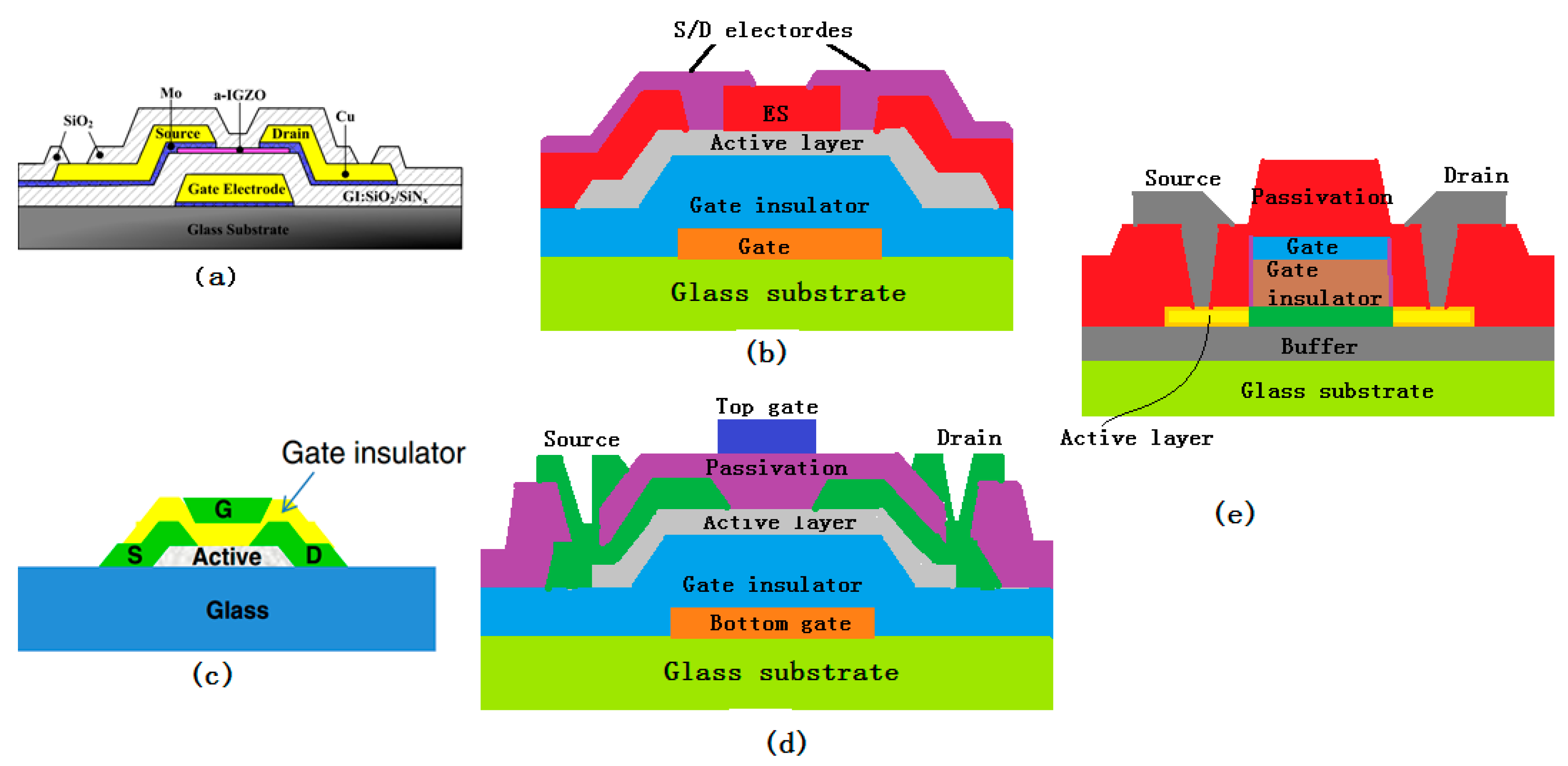
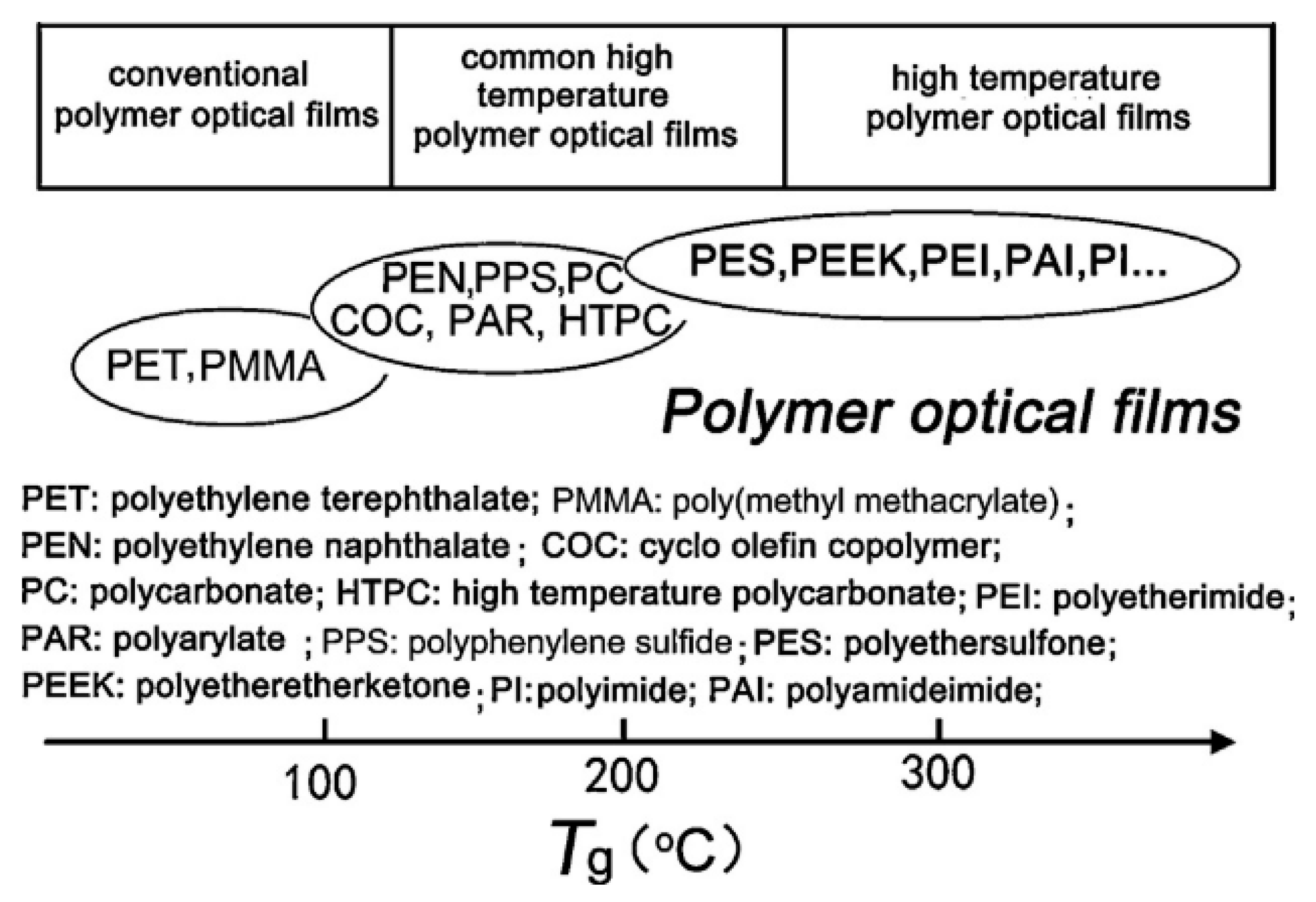


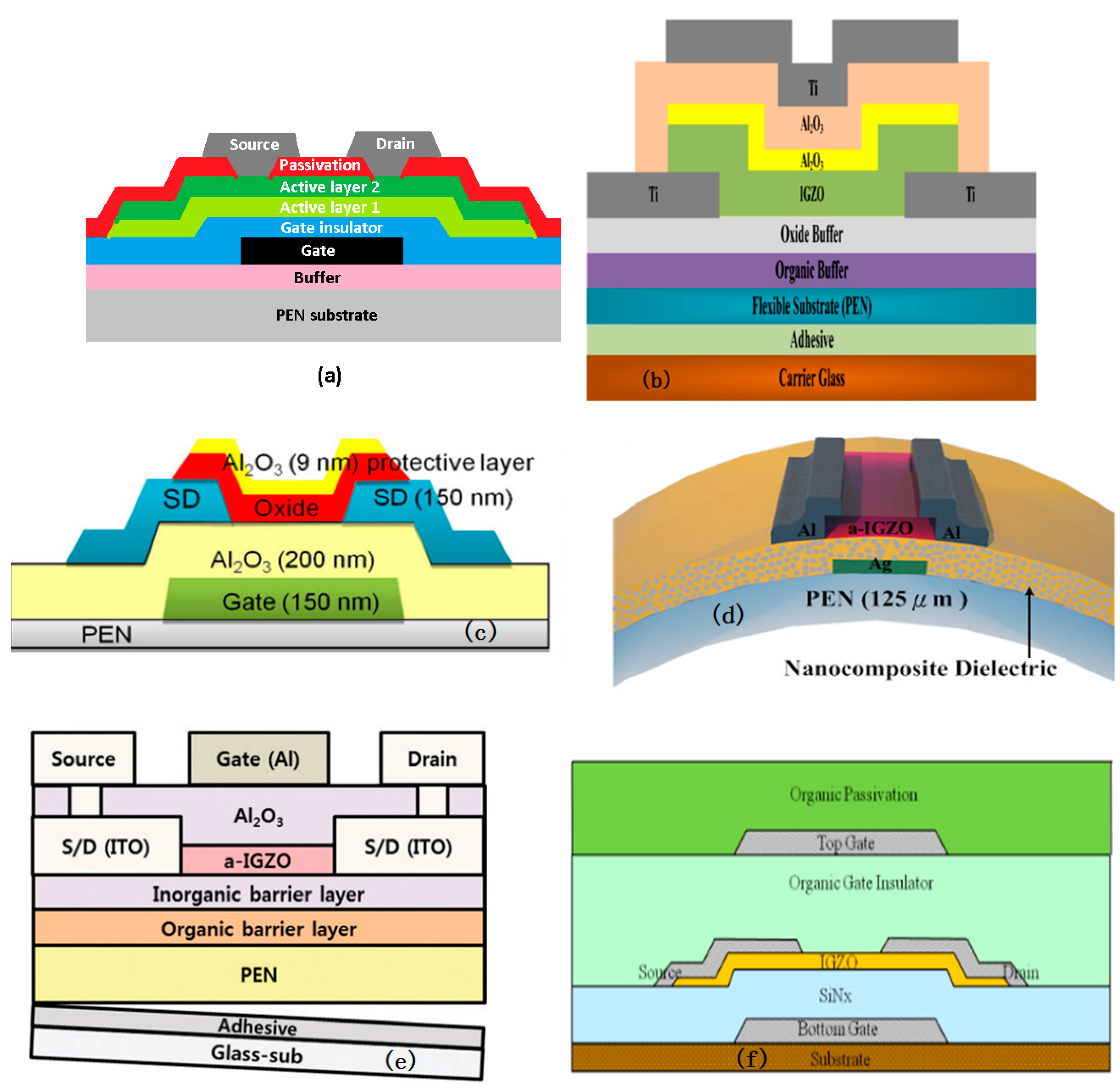
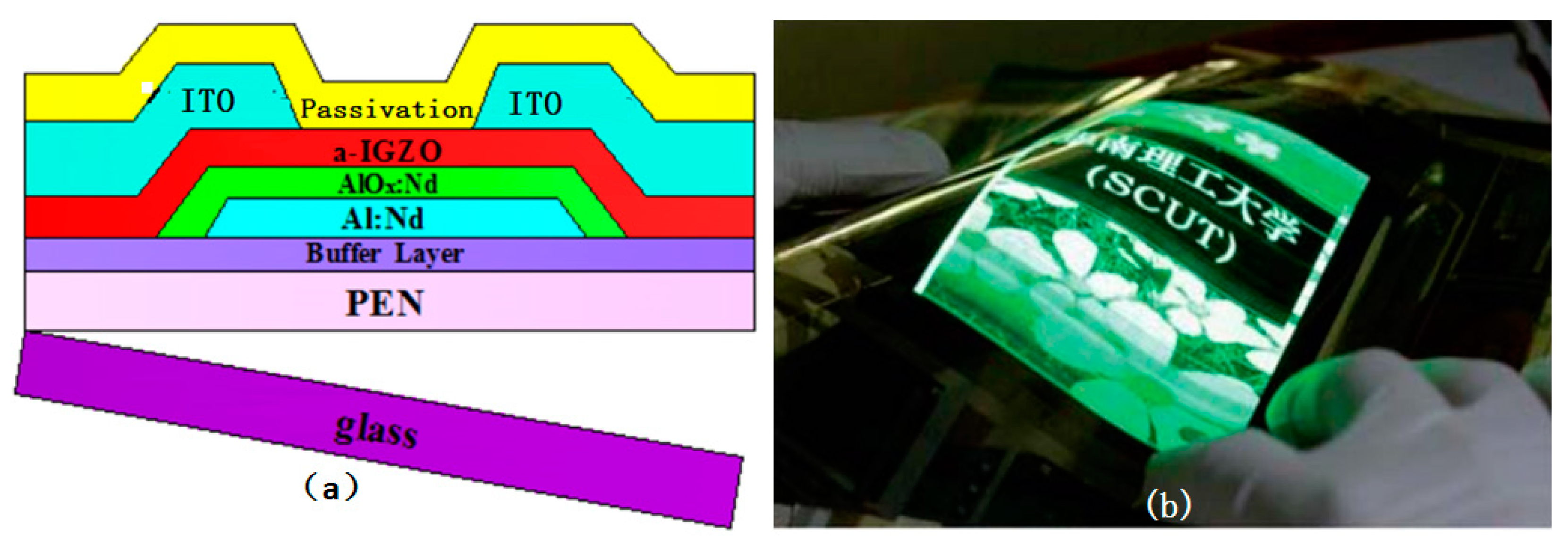

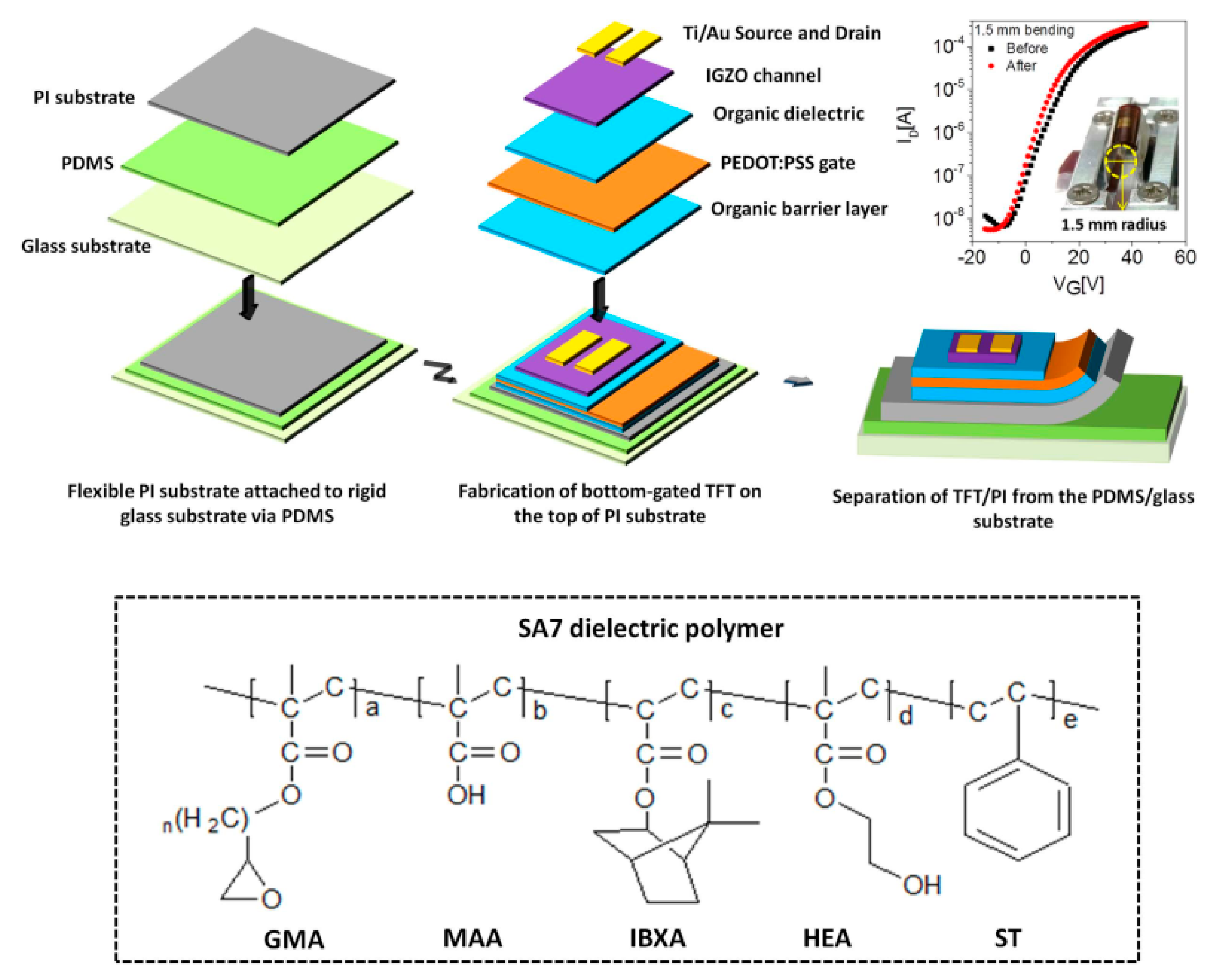
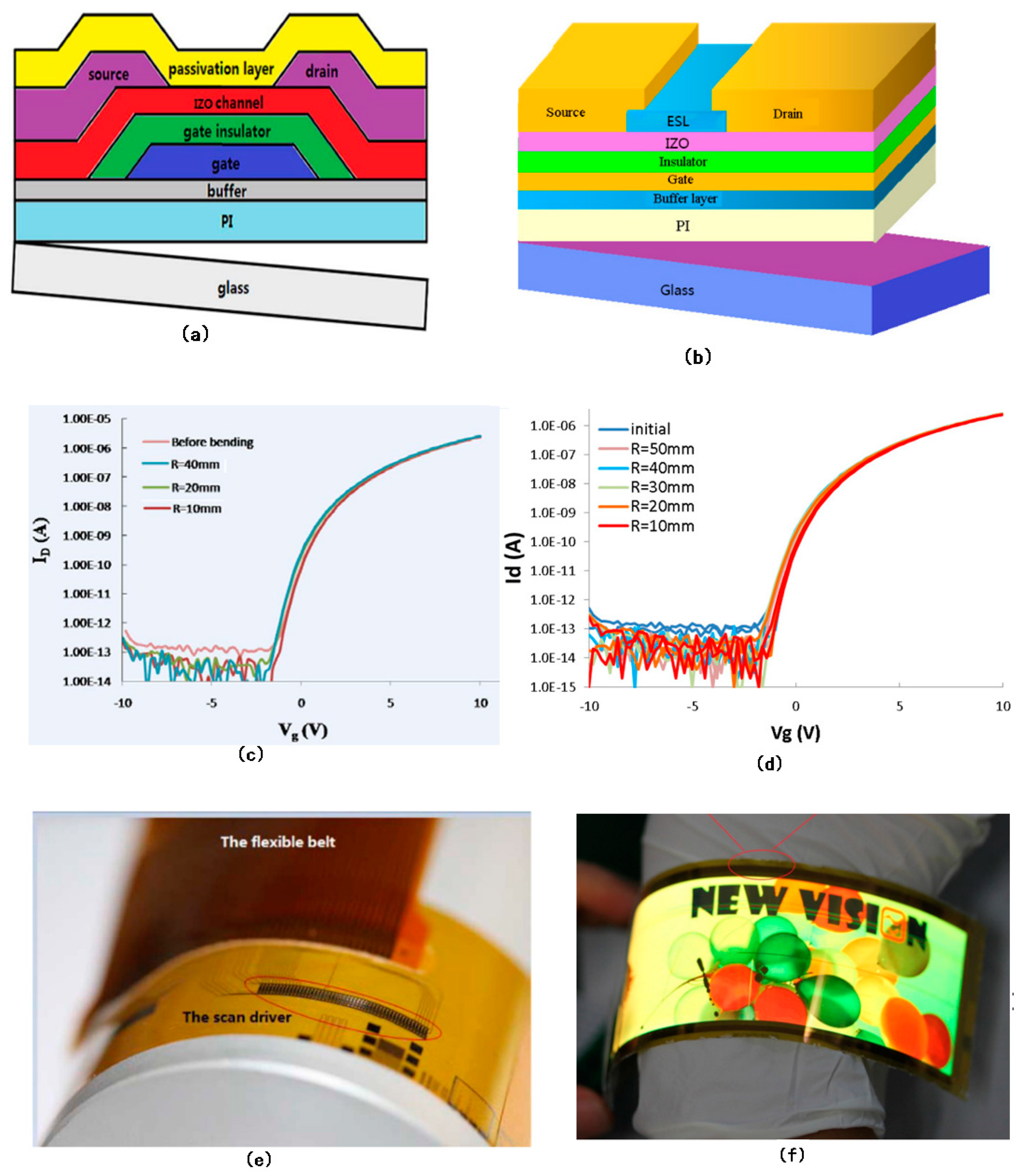
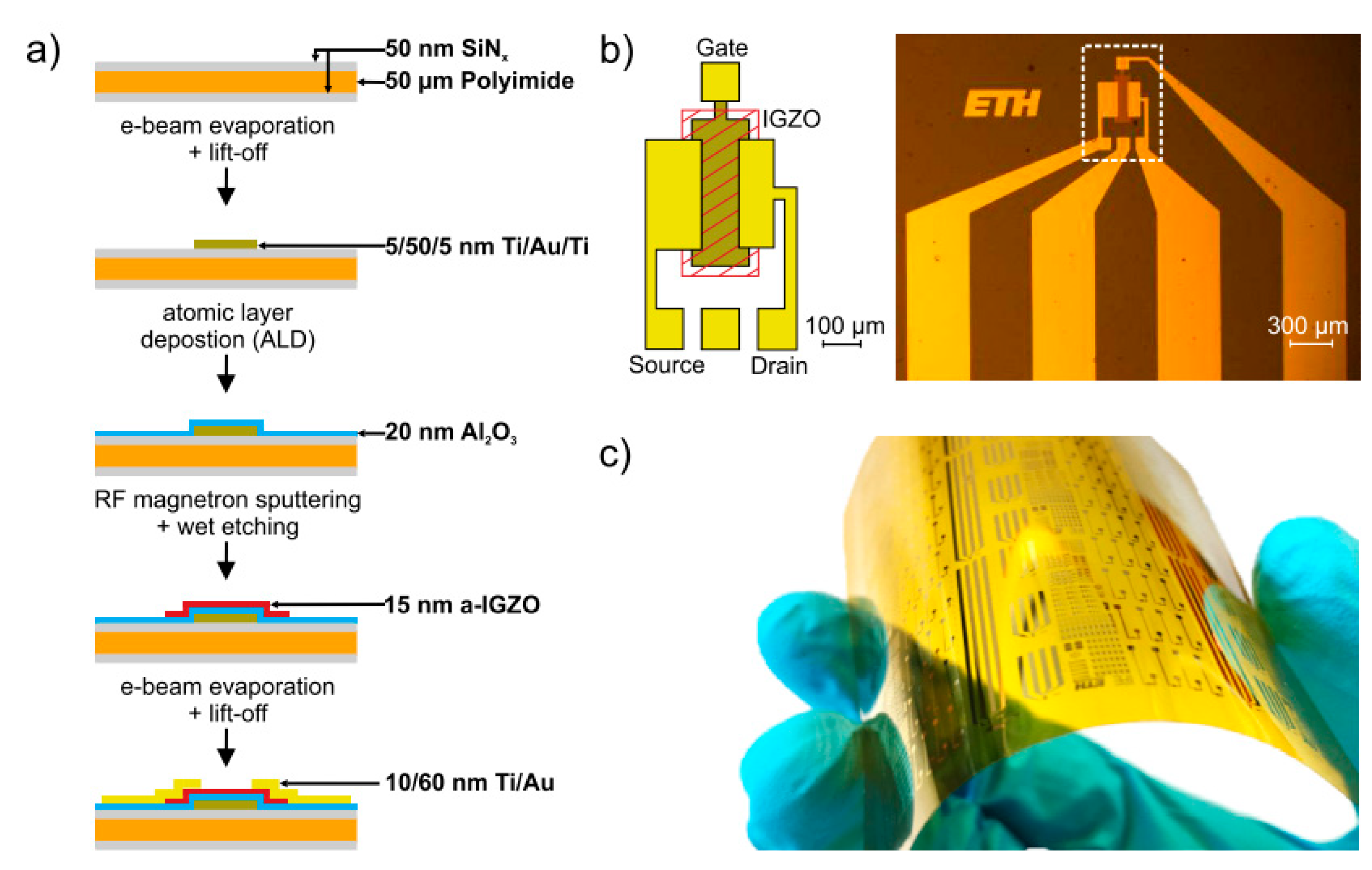



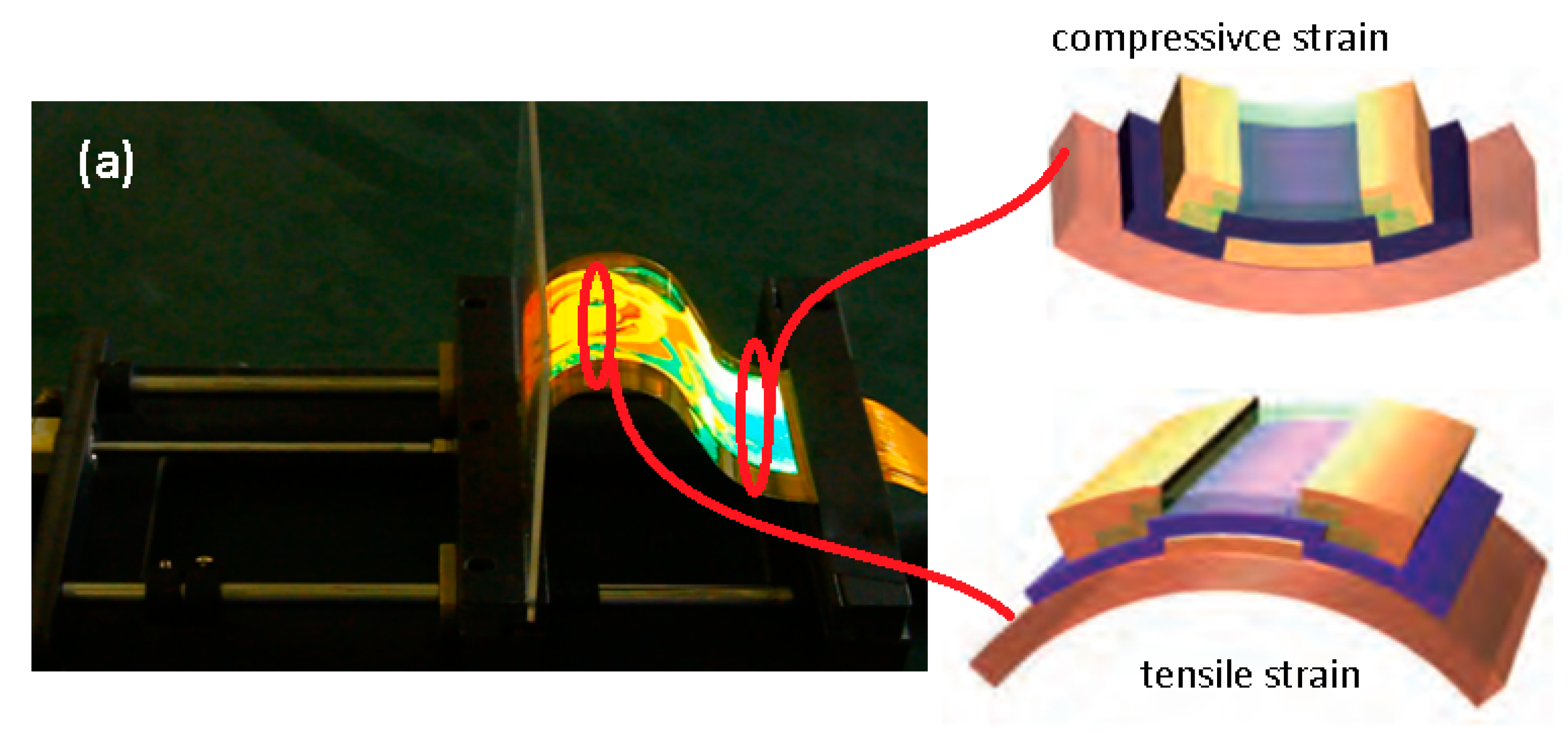



| TFTs | Threshold Voltage (V) | Mobility (cm2 V−1 S−1) | On/Off Current | Subthreshold Swing (V dec−1) | Channel Material | Substrate | Temperature (°C) |
|---|---|---|---|---|---|---|---|
| Reference [71] | 4 | 20 | 105 | 0.26 | a-ZITO | PET | <150 |
| Reference [69] | 5.4 | 7.53 | 104 | >2 | ZnO | PET | <150 |
| Reference [150] | 1.3 | 21.3 | 2.7 × 107 | 0.23 | AZO | PET | room temperature |
| Reference [151] | 2.85 | 8.0 | 2.51 × 107 | 0.23 | InGaZnO | PET | - |
| Reference [57] | 1.2 | 66.7 | 2 × 107 | 0.33 | TZO | PET | 80 |
| Reference [86] | 1.93 | 7.83 | ~108 | 0.24 | IGZO | PEN | 150 |
| Reference [124] | 5.5 | 4.1 | ~108 | 0.2 | IZO:F | PEN | 200 |
| Reference [154] | 4.1 | 15.5 | 2.2 × 108 | 0.2 | IGZO | PEN | 180 |
| Reference [156] | 2.48 | 12.87 | 109 | 0.2 | IGZO | PEN | 150 |
| Reference [157] | 0.1 | 5.39 | 2 × 105 | 0.81 | LZZO | PI | 320 |
| Reference [158] | 0.95 | 10 | 2 × 109 | 0.069 | IGZO | PI | 150 |
| Reference [159] | −0.6 | 9.5 | 4.5 × 108 | 0.109 | IGZO | PI | 150 |
© 2019 by the authors. Licensee MDPI, Basel, Switzerland. This article is an open access article distributed under the terms and conditions of the Creative Commons Attribution (CC BY) license (http://creativecommons.org/licenses/by/4.0/).
Share and Cite
Zhang, L.; Xiao, W.; Wu, W.; Liu, B. Research Progress on Flexible Oxide-Based Thin Film Transistors. Appl. Sci. 2019, 9, 773. https://doi.org/10.3390/app9040773
Zhang L, Xiao W, Wu W, Liu B. Research Progress on Flexible Oxide-Based Thin Film Transistors. Applied Sciences. 2019; 9(4):773. https://doi.org/10.3390/app9040773
Chicago/Turabian StyleZhang, Lirong, Wenping Xiao, Weijing Wu, and Baiquan Liu. 2019. "Research Progress on Flexible Oxide-Based Thin Film Transistors" Applied Sciences 9, no. 4: 773. https://doi.org/10.3390/app9040773
APA StyleZhang, L., Xiao, W., Wu, W., & Liu, B. (2019). Research Progress on Flexible Oxide-Based Thin Film Transistors. Applied Sciences, 9(4), 773. https://doi.org/10.3390/app9040773




